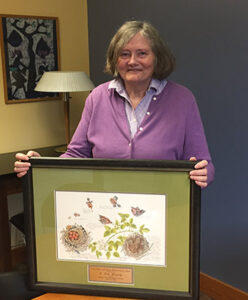Biology’s Dale Kennedy Honored by Wilson Ornithological Society
March 24, 2017

Dale Kennedy with her original painting depicting the nesting cycle of house wrens, which she received as part of her service award at the 2017 annual meeting of the Wilson Ornithological Society.
By Chuck Carlson
Albion College biology professor Dale Kennedy remembers as a kid in New Jersey the image of her dad looking out the window and watching the assortment of birds that used to congregate in their backyard.
And he was transfixed.
“He wasn’t a birder but he knew a lot of birds,” she says.
The memory faded over the years until she was a junior at the College of Wooster and took a course in vertebrate zoology that included the study of birds.
“And it all came back,” she says with a smile.
Since then, Dale Kennedy has been enthralled with the study of the feathery creatures.
Indeed, she went on to gain her master’s degree at the University of North Carolina, with much of her efforts focused on the white-throated sparrow. Then she earned her Ph.D. in ecology at Rutgers University thanks to her study of wrens.
And since 1994, when she began her teaching career at Albion, studying those tiny birds has remained something of a cottage industry for Kennedy and her husband, Doug White, also a biologist at Albion.
In fact, since 1995, Kennedy and White have installed nearly 150 nesting boxes for the migratory birds to lay their eggs, and for the couple to conduct their research.
Located near the College’s student farm in the Whitehouse Nature Center, the ongoing work has provided Kennedy and White with valuable information about the birds.
Kennedy’s research with wrens led her to joining and serving in the Wilson Ornithological Society (WOS), and she was awarded the William and Nancy Klamm Service Award by the society during its annual meeting earlier this month in Fort Myers, Fla.
“I was stunned,” Kennedy says when she learned she had won the award, which has been presented annually by the organization since 2007. “It’s just been a great honor to be involved.”
The WOS was formed in 1888 and is one of the oldest ornithological societies in America. Kennedy has been a member since 1984 and has held just about every position possible in the organization.
She most recently served as immediate past president from 2011-13 and was president from 2009-11. Over the years she was also first and second vice president and a member of numerous committees, including co-organizer and co-chair of a symposium on the biology of wrens.
“It’s been a really wonderful society to be a part of,” says Kennedy, who was presented with an original painting by wildlife artist Julie Zickefoose depicting the nesting cycle of the house wren.
For Kennedy and White, this will be their 23rd year of research into wrens at Albion.
The birds spend the winter on the Gulf Coast and will be making their way back to Michigan in late April. They will lay their first set of eggs in the houses in early May, and a second set toward the end of June and into August.
Kennedy and White also band the birds (between 250 and 500 per year) and use tiny iButton devices in nests to track their incubation patterns. They have often enlisted the help of students; Kennedy estimates more than 60 students over the years have done College research that in some way involves the birds.
For years, the couple has presented results about the birds’ feeding and nesting habits and local movements at national conferences, and they continue their work—every day during the spring and summer—because there’s always something else to know.
“It’s been fun, and we’re still learning,” she says.